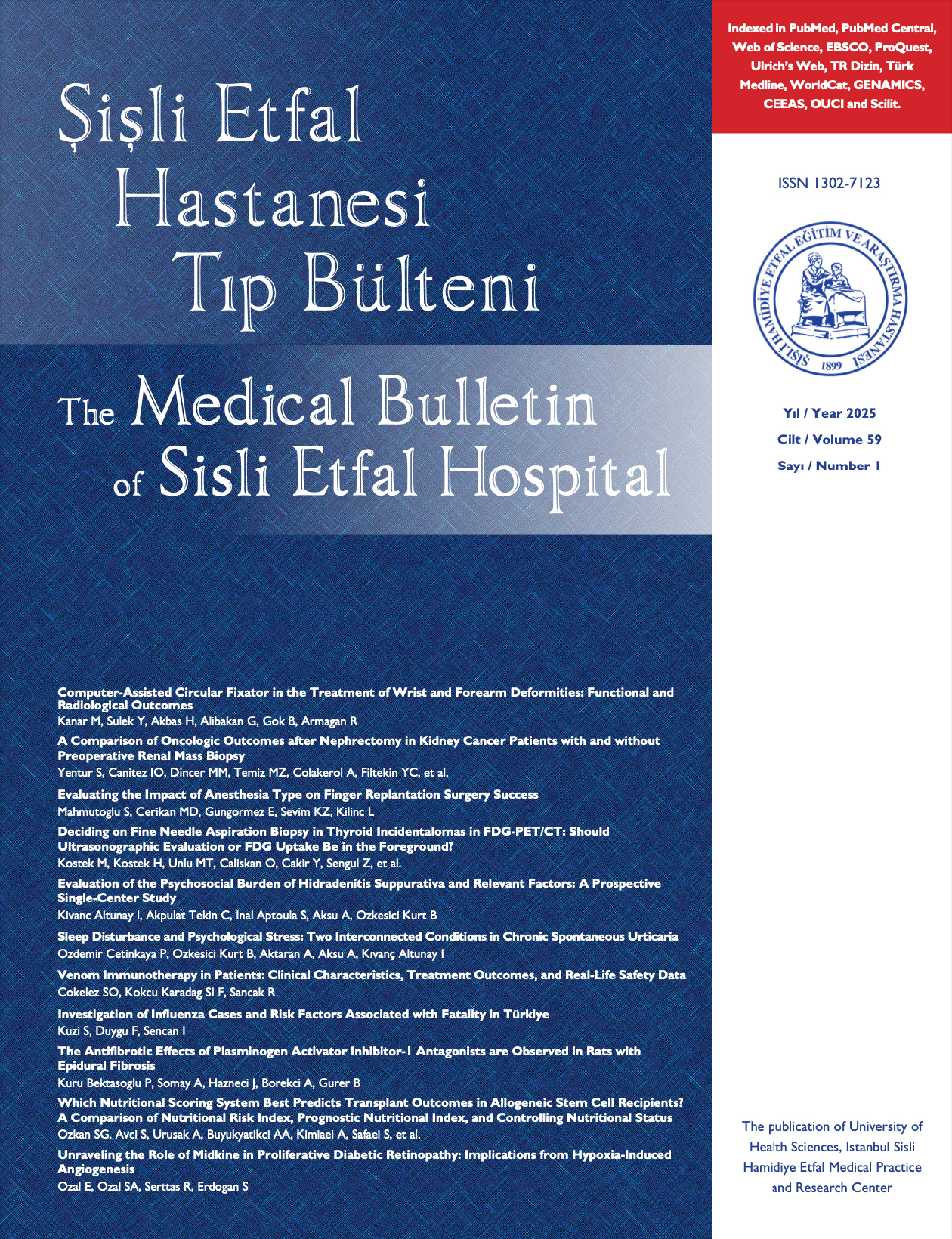
Volume: 48 Issue: 2 - 2014
| INVITED REVIEW ARTICLE | |
| 1. | The effect of antenatal steroid on the early outcome of premature infants Mesut Dursun, Ali Bülbül doi: 10.5350/SEMB.20140331061031 Pages 67 - 78 The care of infants with respiratory failure who required mechanical ventilation holds an important place in the neonatal intensive care units. In the care of these infants; pain control, aspiration method, physiotherapy and providing ideal body temperature constitutes the main principles. To provide proper care will significantly reduce morbidity and mortality of newborn infants. The minimum touch and maximum observation principle should be noted as the most important principle in the care of baby with mechanical ventilation. In this article, the important points will be referred in the care of infants with mechanical ventilation. |
| ORIGINAL RESEARCH | |
| 2. | The related preoperative blood CA-125 value to prognosis at endometrial cancer İbrahim Ömeroğlu, Osman Aşıcıoğlu, Serpil Kırım, Osman Temizkan, Bülent Arıcı, Sibel Özsoy doi: 10.5350/SEMB.20140212044115 Pages 79 - 85 Objective: In this study the relationship of preoperative high CA-125 levels with clinical and pathological prognostic factors were investigated in endometrium cancer patients. Material and Method: The relationship between preoperative CA-125 levels and clinicopathological parameters was investigated on 100 patients who operated for endometrium cancer between April 2007-April 2012 in Department of Obstetric and gynecology at Şişli Etfal Research and Training Hospital. Average age, menopausal status, body mass index, preoperative CA-125 levels, tumor types, histologic grades, surgical-clinical stage, positive peritoneal fluid cytology, presence of lymphovascular invasion, myometrium invasion and its degree, omentum metastasis, and tumor diameter and grade were evaluated. For CA-125 cut off point was accepted as evaluated 35 IU/mL. Results: Cut-off point of CA-125 results of endometrium cancer patients were significantly associated with omentum metastasis, invasion to more than half of the myometrium, positive peritoneal fluid cytology and tumor size larger than 2 cm, lymphovascular invasion and positive lymph nodes. Conclusion: For patients with endometrium cancer, preoperative CA-125 measurement (for cut off point 35) can be utilized as an important factor determining poor prognostic factors. However, it is not suitable to be used as an independent prognostic factor alone. |
| 3. | Research of the efficacy of topical local anesthesia for hysteroscopy: a randomised-controlled trial Resul Karakuş, Hayal İsmailov, Ahmet Namazov, Sevcan Arzu Arınkan, Osman Temizkan, Ali Doğukan Anğın, Sultan Seren Karakuş doi: 10.5350/SEMB2014480203 Pages 86 - 91 Objective: Hysterosalpingography is a procedure to investigate the shape of the uterine cavity and the fallopian tubes especially in the infertile women. As hysterosalpingography is a painful procedure, pain affects negatively the success of the procedure and the comfort of the patient. Purpose of this research is to determine the effect of the lidocaine spray application to the cervix on the pain. Material and Method: This study was performed including the patients who had hyserosalpingography procedure for investigation of infertility at Zeynep Kamil Gynecology - Obstetrics and Pediatrics hospital between 2011 september and 2011 november. Statistical analysis was performed using the SPSS 19 program. Results: When we compare placebo and lidocaine group in terms of pelvic pain reasons such as dysmenorrhea, dyspareunia and history of previous surgery, there was no statistically significant differences. Vizuel Analog Scala score of the instrument application at the placebo group was 2.5±1.2, at the lidocaine it was 1.2±0.8. There was statistically significant difference (p<0.05). There was no statistically significant difference between the groups in terms of VAS score at the 30 minutes after the procedure. When we compare Visual Analog Scale scores between the groups, we found that the most painful step was second injection. Conclusion: Topical anesthesia applied to the cervix only affects to reduce the pain during instrument application. Topical anesthesia is unsufficeint to reduce the visceral pain caused by distension of uterus and tubes. |
| 4. | Bone mineral density and bone fracture relationship in elderly women Bülent Çakmak, Ahmet İnanır doi: 10.5350/SEMB.20131212034545 Pages 91 - 95 Objective: The aim of this study was to compare the bone mineral density in elderly women with and without bone fracture. Material and Method: The records of the ≥ 65 years women patients who had been performed bone mineral density (BMD) measurements in our hospital between January 2010 and June 2012 were evaluated according to their demographic features and BMD measurements retrospectively. Age, body mass index (BMI), menopause period, systemic disease, presence of osteoporosis and BMD were compared between patients with and without bone fracture. Results: Bone fracture was determined in 17 (16.3%) of 102 patient admitted in our study. There was no significant difference between patients with and without bone fracture for age, BMI, menopause period and systemic diseases (p>0.05). Similarly, there was no significant difference between two groups for the presence of osteoporosis, total BMD values and T scores of lomber spine and femur (p>0.05). Conclusion: Risk of bone fracture in geriatric women is not only associated with BMD. We should keep in mind that the risk may be associated with features such as content and structure of the bone and fall common seen in these ages. |
| 5. | The risk factors and perinatal outcomes of shoulder dystocia during delivery Ali Doğukan Anğın, Osman Temizkan, Resul Karakuş, İlhan Şanverdi, Mesut Polat, Pınar Anğın, Selçuk Selçuk doi: 10.5350/SEMB2014480205 Pages 96 - 101 Objective: SD (shoulder dystocia) is an uncommon and unpredictable event complicating 0.23% of all vaginal deliveries. We sought to examine the current risk factors and perinatal outcomes of all cases of shoulder dystocia in a single institution over a five years period. Material and Method: This is a retrospective study carried out at a large tertiary referral center serving a single urban population over a 5 years period from 1998-2013. Shoulder dystocia was defined as failure to deliver the shoulders at the first attempt in singleton cephalic vaginal deliveries. Details of maternal demographics, intrapartum characteristics and neonatal outcomes were recorded prospectively on a computerized database for analysis. Results: Last five years, total number of vaginal birth was 31,497 and the incidance of shoulder dystocia was %0.1 (n=33) in this period. In the shoulder dystocia cases %21 (n=7) of them had gestational diabetes mellitus and only 21% of the patients (n=7) were nulliparous. In %39 (n: 13) of newborns who had sshoulder dystocia were observed signs of brachial plexus injury like moro reflex loss. Newborns who had shoulder dystocia, %39 (n: 13) had 4000 gr and above birthweight but only one of the newborns (%3) who had shoulder dystocia had antenatal ultrasonographic measurement of estimated fetal weight over 4000 grams (4050 gr). 3(%9) of newborns needed to be followed up in neonatal intensive care unit. Newborns who had shoulder dystocia were divided into two groups: babies with (n=18, %54) or without (n=15, %46) complication because of shoulder dystocia. Brachial plexus palsy was significantly more common among episiotomy + maneuver, compared with maneuver-only and episiotomy-only (p: 0.046). Conclusion: We consider this robust and significant data relating to contemporary antecedents and outcomes of SD. As a complication which carries a significant risk of persistent neurological injury for the infant and consequent medicolegal implications for the clinician, continuous audit and high levels of awareness and training for all birth attendants should now be standard practice. |
| 6. | Comparison of dexmedetomidine and remifentanil sedation in spinal anesthesia Çiğdem Yıldırım, Hale Dobrucalı, Ayşe Hancı, Hacer Şebnem Türk, Pınar Sayın, Oylum Selçuk doi: 10.5350/SEMB.20131125031052 Pages 102 - 108 Objective: In orthopedic procedures spinal anesthesia is often the preferred method. When performing a spinal anesthesia, sedation is also applied in order to tolerate the operation. Sedative agent that used needs provide rapid onset and recovery, should have minimal side effects. Our study aimed to compare the sedation quality, the hemodynamic and respiratory effects of remifentanil and dexmedetomidine infusion for sedation in patients undergoing spinal anesthesia during orthopedic procedures. Material and Method: For study 90 subjects (ASAI-III) who underwent lower extremity surgery under spinal anesthesia were included. The age ranged between 20 and 60 years. This study is a prospective, randomized, controlled study. For spinal anesthesia, between L4-L5 distance, 2 ml of 0.5% hyperbaric bupivacaine was administerd and unilateral spinal anesthesia was achieved. In group 1, 20 ml / 10-minute loading dose followed by 15 ml/h infusion of 0.9% NaCl solution. In group 2, 0.5 mcg/kg (20 ml) 10-minute loading dose followed by 0.2 mcg/ kg/h dexmedetomidine infusion. In group 3, 0.5 mcg/kg (20 ml) 10-minute loading dose followed by 0.1 mcg/ kg/h remifentanil infusion. Of the cases, before the spinal block (BB), after the block (AB), at the 1st, 5th, 10th, 15th, 20th minute of sedation and 10-minute intervals until the end of operation; mean arterial pressure (MAP), heart rate (HR), respiratory rate (RR), peripheral oxygen saturation (SPO2), sedation and nausea, vomiting, bradycardia, hypotension, desaturation, respiratory depression such side effects have been recorded. Results: The age, sex, weight, height averages and duration of operation did not significantly differed between groups. In group 3 HR was observed significantly lower than group 1 and 2 (p<0.05). At all times MAP measurements significantly decreased in all groups when compared with before sedation measurements (p<0.05). There was no significant difference between the groups in terms of respiratory rate and SPO2. When the Ramsay Sedation Scores (RSS) were compared; in group 3, a significant increase was observed at 1th minute of sedation when compared with before sedation scores (p<0.05). In group 2 and 3 no significant difference was observed between before sedation and after sedation scores. There was also no significant difference between RSS scores and complication distrubition between groups. Conclusion: Remifentanil used for sedation, during spinal anesthesia, provides more stable hemodynamics. Remifentanil and dexmedetomidine showed similar sedative effects, with a low incidence of side effects. Although dexmedetomidine and remifentanil sedation scores were similar to the control group, they provide a clinically effective sedation. Low doses of dexmedetomidine and remifentanil can be used safely for sedation during regional anesthesia. |
| 7. | Evaluation of the neonates with anomalies of the external genitalia in our hospital Evrim Kıray Baş, Ali Bülbül, Selda Arslan, Sinan Uslu, Nurçin Saka, Asiye Nuhoğlu doi: 10.5350/SEMB.20140130040119 Pages 109 - 112 Objective: To determine the prevalance of external genital abnormalities among neonates in our hospital. Material and Method: A total 3437 neonates delivered at Şişli Hamidiye Etfal Hospital between January 2010- December 2010 were examined at birth for external genital abnormalities. The presence of cliteromegali, inguinal / labial mass, hypospadias, micropenis, and undescended testicles and ambigus genitalia were examined. Results: The study identified 20 (6/1000) neonates with external genital abnormalities. All of them were examined within 3 days of life. Morphological abnormalities comprised: undescended testes (cryptorchidsm)(12/20), isolate hypospadias (5/20), cliteromegali (1/20), epispadias (1/20) and ambiguous genitale (1/20). The incidence of hypospadias and cryptorchidism were found 0.34%, 0.23%, respectively. Prematurity occured in 4/20 cases. Congenital adrenal hyperplasia were detected in two cases. Conclusions: External genital anomalies are among the most common congenital anomalies. Proper early diagnosis and management of genital abnormalities are of great importance to minimize medical, psychological and social complications. Our result reinforce the importance of a careful examination of genital morphology in neonatal period towards the recognition of minor defects that can be clinical features of a disorder of sex devolpoment. |
| 8. | The efficiency of preoperative tumor marker levels for definition of malignancy and spread in adnexial masses İbrahim Ömeroğlu, Osman Aşıcıoğlu, Gürsel Otlu, Osman Temizkan, Sibel Özsoy, Ramazan Adan, Berhan Besimoğlu Aşıcıoğlu, Ali Şahap Odacılar doi: 10.5350/SEMB.20140415023944 Pages 113 - 118 Objective: The place of CA 12-5, CA 15-3, CA 19-9, CEA, AFP and ß HCG, which are tumor markers used in screening over carcinoma, in differentiating benign or malign adnexial masses, and the correlation of these markers with the pathological diagnosis and stage of the tumor were evaluated. Material and Method: Two hundred seventy seven patients who were operated with the diagnosis of adnexial mass at Şişli Etfal Training and Research Hospital Gynecology and Obstetrics Clinic between January 2006 and August 2011 were analyzed retrospectively. Results: Efficiency levels of tumor markers as diagnostic tests were studied by ROC curve method. The area under the ROC curve was calculated as 0.872 unit frames for CA 12-5, 0.739 for CA 15-3, 0.522 for CA 19-9, 0.614 for CEA, 0.433 for AFP and 0.635 for ß HCG. Conclusion: Markers other than CA 12-5 and CA 15-3 could not found significant in the statistical evaluation for the discrimination of benign and malignant. The discriminative power of each tests were analyzed by statistical ROC curve method. At the analysis, CA 12-5 was found as the most valuable marker. While the discriminative value of CA 15-3 was found acceptable, other tests were found invaluable. Only CA 12-5 had showed a correlation with the tumor stage. |
| 9. | The comparison of ureteroscopy and ureterolithotomy for the treatment of large and impacted ureteral stones in the middle and upper part of ureter Göksel Bayar, Umut Sarıoğulları, Hüseyin Acinikli, Mehmet Taşkıran, Elshad Abdullayev, Muammer Kendirci, Kaya Horasanli, Orhan Tanrıverdi doi: 10.5350/SEMB.20140429075756 Pages 119 - 123 Objective: We aimed to research the most effective treatment method of the middle and upper ureteral impacted stones of which is 1.5-2 cm diameter size. Material and Method: Between 2000 and 2013, 75 patients who had impacted stone size of between 1.5-2cm at the middle and upper part of the ureter were examined. Patients had been analysed in terms of their demographical characteristics, stone size, hospitalization time, stone- free and complication rates. For statistical analysis Pearsons chi-square, Mann Whitney-U and student-t tests has applied. The significance level is determined as p<0.05. Results: Sixty five ureteroscopy and twenty four ureterolithotomy, a total of 87 treatment method had been given to 75 patients. Ureteroscopy had been applied by semi rigid ureteroscope. Eleven of twenty four patients ureterolithotomy were open surgery and 13 were laparoscopic ureterolithotomy. Stone size wasnt greater in the group which has received ureterolithotomy examination compared to group received ureteoscopy examination (503-395 mm3 p=0.172). The hospitalization times was similar for each group (3.4-4.1 days p=0.086). The stone- free rate was 96% for ureterolithotomy group and 46% for ureteroscopy group. Ureterolithotomy has been found more successful then ureteroscopy (p=0.01). Although ureterolithotomy group has only one complications (4%), 1 patient in ureteroscopy group faced with total avulsion and 2 patients were faced ureteral perforation (6.3%). Conclusion: Due to the failure of semi rigid ureteroscope and the high major possibility of complication even if there is not a flexible ureteroscope option, laparoscopic ureterolithotomy or open surgery can be applied instead of ureteroscopy for the treatment of stones which is seen at the upper and middle part of the ureter. |
| 10. | The relationship between breast feeding and depression in the early postpartum period Hava Özkan, Zehra Demet Üst, Gülsüm Gündoğdu, Ayla Çapık, Safiye Ağapınar Şahin doi: 10.5350/SEMB.20140206061410 Pages 124 - 131 Objective: The objective of this study was to determine the relationship between breast feeding and postnatal depression in mothers in the early postpartum period. Material and Method: This descriptive and correlational study was conducted at the maternity hospitalin the city center of Erzurum between 1 February 2013 and 30 April 2013. The data were collected using the Introductory Information Form, LATCH Breastfeeding Assessment Tool and Edinburgh Postnatal Depression Scale. One way analysis of variance, t test, Kruskal-Wallis, Mann-Whitney U and correlation analysis were used to assess the data. Results: It was determined that there was a statistically significant difference between the age, educational level and pregnancy number of mothers and LATCH mean scores (p<0.05), and a statistically significant difference between the EPDS mean scores and income level, pregnancy number and pregnancy intention of mothers (p<0.05). According to these results, no relationship was determined between LATCH and EPDS mean scores. Conclusion: As a result of the study, it was determined that mothers had a moderate-level success of breast feeding, one fourth of them were under risk in terms of depression and there was no relationship between the depression and breast feeding. |
| 11. | Evaluation of nutritional status and its effect on biochemical parameters in eldery people admitted to home health care services Aydan Çevik, Okcan Basat, Sema Uçak doi: 10.5350/SEMB.20140507030931 Pages 132 - 139 Objective: Malnutrition and undernutrition are common phenomena in elderly. Prevalence of malnutrition is even higher in older people admitted to home health care services. Our aim was to evaluate the nutrioional status and its effect on biochemical parameters of the elderly people admitted to home health care services. Material and Method: Our study was performed in 178 participants admitted to the home health care services. Validated Mini Nutritional Assessment (MNA) form was used and biochemical tests were performed. For statistical analyses NCSS 2007& PASS 2008 Statistical Software was used and p<0.05 was considered as statistically significant. Results: Main age of the participants is 81.19±8.22 years and 32% of participants were male, 68% were women. According to MNA 33.1% were malnourished, 39.3% were under malnutrition risk and 27.5% were in normal nutritional status. Hemoglobin, total iron, total iron binding capacity (TIBC), vitamin B12, folic acid and lymphocyte levels were significantly lower, ferritin and C-reactive protein levels were significantly higher in malnutrition group. Total iron and albumin levels were significantly lower and CRP levels were significantly higher in undernutrition group compared to subjects with normal nutritional status. Conclusion: Elderly people given home care are under greater risk of malnutrition. If not appropriately managed, malnutrion is associated with higher morbidity and mortality. Therefore it is essential to closely monitor the nutritional stutional status of the elderly people who are admitted to home health care services. |
| 12. | Peroneal nerve paralysis: Characteristics and therapeutic results of eight operated cases Selim Kayacı, Vaner Köksal, Serkan Kırbaş doi: 10.5350/SEMB2014480212 Pages 140 - 144 Objective: Peroneal nerve paralysis is one of the peripheral nerve lesions often seen in the lower limb. In this paper, characteristics and surgical treatment results of eight cases in whom peroneal nerve injury developed due to mechanical, traumatic and postural reasons were investigated. Material and Method: Between April 2011 and November 2013, eight patients who referred to our clinic due to lower leg related to peroneal nerve injury were treated. In order to diagnose the illness and determine the level of injury, electromyography (EMG) and neural transmission speed study were carried out on all patients. During motor assessment, strong sides of patients were compared. Results: Six of the patients were men and 2 of them were women, and average age was 41.9±4.2 (range: 23-72). One of the patients had an ankle sprain history, two of them had a history of long term practice by falling on their knees, in two a history of wearing top boots or wellies, in other two patients a history of waiting for hours by crossing their legs, and one patient had a trauma history on knee-joint level after a traffic accident. Average duration of symptoms and findings were 3.8 months (range: 3-6 months) A very serious slowness in the transmission speed and an amplitude block were seen in main peroneal nerve and at a level of fibular head during the EMG done to the patients. All the patients were treated at the level of fibular head by doing peroneal nerve decompression. Conclusion: Peroneal nerve is usually pinched in fibular head or neck side. In the cases not responding to conservative treatments, satisfactory results are generally obtained by freeing of nerve at fibular head level. |
| CASE REPORT | |
| 13. | Longitudinally extensive transverse myelitis: case report Tuğce Toptan, Betül Özdilek, Gülay Kenangil, Füsun Mayda Domaç, Mustafa Ülker doi: 10.5350/SEMB2014480211 Pages 145 - 148 Longitudinally extensive transverse myelitis is an inflammatory demyelinating disease of the central nervous system which affects the spinal cord. It may be a spectrum of neuromyelitis optica (NMO) syndrome. NMO is a relapsing disease which is usually associated with increased disability and morbidity. Here we report a 61 year-old woman with subacute left hemiparesis, who had paraparesis and quadriparesis, each once in the past. Magnetic resonance imaging revealed lesion areas throughout all the cervical segments. During etiological research, anti-aquaporin 4 antibody was found positive. With this case report, we aimed to emphasize the importance of measurement of anti-aquaporin 4 levels in patients with transverse myelitis. |
| 14. | Vena cava tumor Muharrem Battal, Oğuzhan Karatepe, Fevziye Kabukçuoğlu, Bülent Çitgez, Adem Akçakaya doi: 10.5350/SEMB.20140220083402 Pages 149 - 152 Vena cava tumor is a rare tumor and its surgical procedure is unique. A women patient, 55 years old, referred to our hospital becouse of intraabdominal mass. After preoperative preperation, the patient was operated for vena cava tumor. Total tumor excision and partially vena cava resection were performed and vena cava was repaired with synthetic vasculer graft patch. In pathological examination of mass, spindle cell sarcomatous malignant tumor was detected and it was interpreted as moderately differentiated leiyomyosarcoma. A rare clinical condition of this case was discussed together with literature. |
| 15. | The dorsum of hand-foot edema to diagnosis: Turner Syndrome Evrim Kıray Baş, Yusuf Ünal Sarıkabadayı, Meral Barlık, Ayşe Gümüş Demirçubuk, Metin Karcın, Beltinge Demircioğlu Kılıç doi: 10.5350/SEMB.20140220112530 Pages 153 - 156 Turners syndrome (TS) is one of the most common chromosomal abnormalities with an estimated frequency among female live birth of 1/4000-8000. In this article, we presented a 10 day-old girl who admitted with carpal-pedal edema, with 45, X0 karyotype. The literature about Turners syndrome was reviewed. |
| 16. | Diffuse cavernous hemangioma of the rectum: magnetic resonance imaging features: a case report Ahmet Mesrur Halefoğlu, Emel Kaya, Betül Duran Özel doi: 10.5350/SEMB.20140327095138 Pages 157 - 160 Diffuse cavernous hemangioma of the rectum (DCHR) is a rare benign vascular lesion usually seen in young adults. The presenting symptom is painless recurrent rectal bleeding. Herein, we report a 5 yearold male patient with a history of DCHR. He had been diagnosed with DCHR at his birth. The definite diagnosis was made on the basis of biopsy wich was performed during colonoscopic examination. The patient underwent magnetic resonance imaging (MRI) examination which revealed characteristic signal intensity features of the tumor and also determined the exact location and extent of the lesion. The tumor had only minimally progressed in size compared to the last MRI examination. Currently, the patient is on medical treatment and being followed up by MRI. DCHRs are rarely encountered and often misdiagnosed because they can mimic internal hemorrhoids, inflammatory bowel disease, carcinoma and various other pathological conditions. In conclusion, we can emphasize that despite its rarity, DCHR should be considered in the differential diagnosis of young patients presenting with painless recurrent rectal bleeding. |



















